How Does Carbon Pollution Impact Our Ocean
The well-being of our ocean depends on emissions reduction.

We’ve heard so much about the effects of climate change on our ocean. Carbon pollution from fossil fuel use and land development have heated the atmosphere and ocean. When carbon pollution enters the atmosphere, the extra gas in the atmosphere begins trapping heat that would have escaped into space. That heat then warms the land, the atmosphere, and the ocean. The ocean has absorbed about 90% of the heat caused by carbon pollution and other greenhouse gases humans have emitted.
Warming oceans are already leading to sea level rise, stronger storms, fisheries’ moving poleward, and widespread loss of sea ice and glaciers. Carbon pollution is also acidifying our ocean; together with warming and its consequences (including oxygen loss and ocean circulation changes), these changes are upending the millennia of normalcy that marine life and ocean-dependent people have built their existences on.
Get Ocean Updates in Your Inbox
Sign up with your email and never miss an update.
The effects of ocean climate change on people are also clear. Communities are becoming used to everyday flooding, while also being torn apart more often by severe storms. Fishermen are traveling farther to catch the same species. Indigenous peoples cannot hunt and fish as freely and successfully as they once did, harming their nutrition, cultures and even languages.
Do you know what our ocean will look like if we DO cut carbon pollution swiftly? It’s true that some climate-driven changes are already locked in. But no matter how big the job seems, if we keep fighting for ambitious, fast carbon-pollution cuts that will keep us in line with a 1.5 degree Celsius future, there’s a lot of hope left for the ocean.
Here are the ways cutting carbon pollution more aggressively and limiting climate change will help the ocean:
- Slowing down warming, acidification and deoxygenation will give marine species and people more time to adjust to “new normal” conditions.
- Limiting our peak global temperature will avoid the widespread extinction of marine species and collapse of marine ecosystems.
- Limiting ocean warming, acidification and oxygen loss can limit deep-ocean species losses. We don’t even know a lot about many deep-sea species yet!
- Substantial changes in seasonal ocean processes that underpin our ocean’s wellbeing, like the start of the spring phytoplankton bloom, will be much less widespread.
- Slowing sea level rise will allow coastal systems, like wetlands and mangroves, to help protect coastal communities better and allow human communities to prepare more thoroughly.
We are already seeing some of these impacts of climate change on our ocean. While there are ways we can help promote coastal resiliency and help ocean ecosystems adapt to these changes, we still need to cut carbon emissions to avoid these ocean symptoms of climate change from worsening to a point that we can no longer treat them. Keeping future conditions near a warming temperature of 1.5 degree Celsius will help avoid social and ecological tipping points – situations where systems reshuffle so much in response to climate change that they behave in ways that are entirely new to us.
The more emissions we can reduce now, the more options we have available to us to adapt and survive the impacts of climate change. Our team at Ocean Conservancy is hard at work promoting the best ocean-based climate solutions from reducing emissions in the shipping industry to ensuring a 100% clean energy future for our ocean. You can take action today to support our climate work and call for emissions reductions in the United States and around the world.